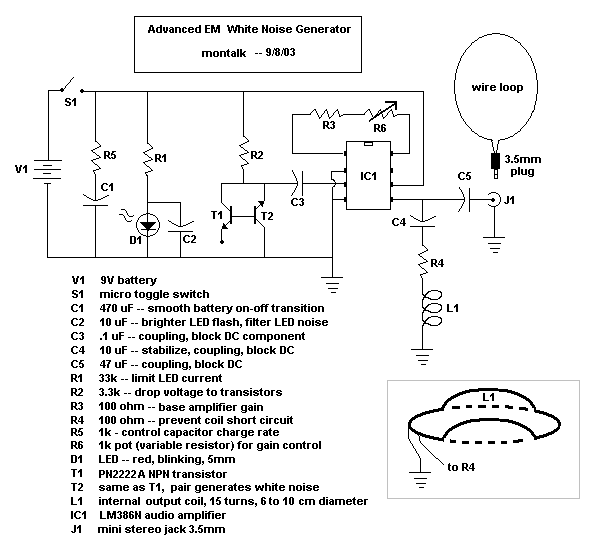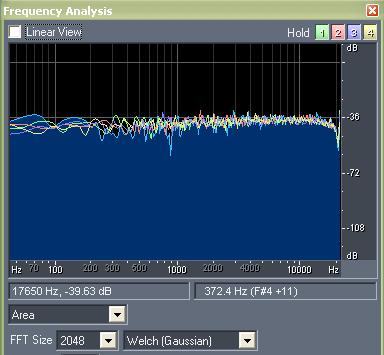How to Build an Experimental EM White Noise Generator
montalk 19/9/03
This article describes how to generate audio and electromagnetic white noise covering frequencies between 0 Hz and 2 Mhz. The device needed is reasonably simple to build and the electromagnetic field it generates is no greater in amplitude than most FCC-approved electronic gadgets. Its frequency spectrum is relatively flat, indicating its output consists of good quality white noise. Included in this article are schematics for both simple and advanced versions, along with construction tips and discussion of how the circuit works and what it does. Its uses are speculative and the device is experimental, though signal theory suggests possible applications.
THEORY
Noise reduces signal clarity, that much is obvious. For example, it's harder to hear someone in a noisy room than a quiet room. Signals are simply waves or pulses that carry information. There are many types of waves - electric waves, sound waves, and electromagnetic waves to name a few.
Anything that involves oscillating electrons will usually emit electromagnetic signals.For example, our brains emit weak electromagnetic (EM) signals because our nervous system communicates using electric waves. Heart pulses likewise emit EM signals with every pulse, and technology exists to remotely detect these to locate hidden behind walls. More exotic technology can intercept and decode brainwaves, allowing monitoring of thoughts and feelings. The reverse process, using properly designed EM signals, can remotely transfer information to the nervous system and affect it in a controlled manner. Is it possible to interfere with the remote interception and transfer of these signals?
Maybe.
White noise is a signal consisting of an even distribution of all frequencies within a given range, whose individual amplitudes change randomly with time. According to standard signal theory, if such noise exceeds the frequency bandwidth and amplitude of a signal, the information in the signal is lost. Therefore, my hypothesis is that an electromagnetic white noise field with sufficient bandwidth and amplitude can interfere with the electromagnetic monitoring and remote influencing of the nervous system. Whether this actually works is left for experimentation. The idea sounds promising and is worth trying out.
So far I have built three such devices, one basic and two advanced models. Below are construction details of the Electromagnetic White Noise Generator (EMWNG) for those who wish to experiment.

The circuit is simple and works as follows: T1 and T2 together function as a diode junction. Be sure to use the PN2222A in the configuration as shown. Current passing across this junction is erratic due to the purely random motion of electrons hopping across the barrier. This randomness is based on quantum and thermodynamic factors and are therefore truly unpredictable. Thus, after interception the white noise cannot be separated from the target signal via an algorithm because it cannot be predicted. The capacitor C3 lets through only the white noise signal from T1 and T2, which is then amplified by the LM386 chip. Resistor R3 increases the gain of the LM386 to a factor of 100. The output goes through another coupling capacitor C5 and the signal exits through an audio jack.
Plugging computer speakers or headphones into the jack will allow one to generate audio white noise. To generate electromagnetic white noise, a large loop of wire running around the edge of your room, or a smaller coil, can be plugged into the output jack. The smaller coil will create a field strong enough to fill an AM radio with static when held a foot or two away from the coil, no matter what places on the dial the radio is tuned. This shows that despite the LM386 being designed for audio frequencies, it still amplifies frequencies up to at least 2 Mhz. It also proves that the coil does put out electromagnetic white noise. The larger loop of wire around the edge of a room will bathe the entire room in a white noise field. An AM radio placed in such a room will receive white noise practically everywhere it is placed. Therefore, I a large loop is preferred over a small coil, except in cases where portability is desired.
This basic design can be jazzed up with a few modifications:

For the "advanced" version above (it's really not that advanced, just more tedious to build) I added a blinking indicator light to show when the device is on. The blinking LED conserves battery power because it's not constantly on. Capacitor C2 shorts out any noise the LED generates, and also gives the light a brighter but shorter burst of light. Also added are buffer capacitor C1, together with R5, to reduce the annoying "pop" sound when the switch is turned on and off when using headphones or speakers. R3 has been reduced to 100 ohms, which increases the amplifier gain to its maximum value, and audio potentiometer R6 in series allows the gain level to be varied.
L1 is a small hoop of wire placed inside the device itself - this way, if stuck in a pocket or set on a nightstand, it will by itself radiate electromagnetic white noise. This smaller coil has two sides innovatively bent upward to increase the spherical coverage of the EM field, otherwise the field is merely doughnut shaped and misses several spots. The output jack still allows a room-sized loop of wire to be plugged in, as in the basic version.
MISCELLANEOUS CONSTRUCTION TIPS
Most parts can be bought at Radio Shack. For the advanced version, I ordered parts online to customize the device into an elegant package. It is housed in a Hammond Mfg instrument enclosure (the size of a remote control) that comes with a 9V battery compartment. Other parts I ordered: pad-per-hole PC board from Radio Shack, nylon board standoffs, 8 pin DIP socket for the LM386, two-hole PC board terminal for L1, and heavy duty battery clip.
Most circuit board connections were made not with wire, but with solder lines going from pad to pad on the PC board. This gets tricky when making the circuit compact enough to fit in the enclosure, so be forewarned unless you use a bigger enclosure or just make your own printed circuit board. Also, have fun creating L1 - it needs to be just the right size to squeeze into the enclosure with room left for the cover, battery, and circuit. The front panel has mounted upon it a micro toggle switch, potentiometer with knob, and audio jack. The audio jack I used has a clear cover on one side, and I mounted the LED indicator light on the PC board to shine through that clear cover - from the front of the panel the audio jack's hole blinks red from the inside. This saves space and looks cool.
ANALYSIS
Plugging the device into my computer and using CoolEdit to do a Fourier analysis of the frequency spectrum gave the following result:

This shows a reasonably flat frequency response. That means there is an even distribution of frequency components from 0 Hz up to 20 kHz. The graph drops off to the right because my computer's sound card cannot sample such high frequencies. Nevertheless, the white noise spectrum continues well past 20 kHz, all the way up to at least 2 Mhz because an AM radio will pick up the EM field generated. Therefore, it's safe to say that the EMWNG (both basic and advanced versions) generate white noise with a bandwidth of 2 Mhz. Note that this covers frequencies in the ELF range.
Output power is minimal and the broadcast field is local, limited to within the room. It does not interfere with radios in the neighborhood or even next door. It does not generate any more noise than an FCC approved device. Nevertheless, for a room-sized loop the field is uniform and definitely there.
POSSIBLE APPLICATIONS
So what else can be done with an EMWNG? That's for you to figure out. All I will say is this: any signal of the same medium that is weaker in amplitude and more limited in bandwidth than the white noise field will become scrambled. This includes audio signals, if speakers are plugged into the device, and subtle electromagnetic signals if a coil or loop of wire is used instead. Use ingenuity.
CONCLUDING REMARKS
Knowledge and spiritual development are preferred over technological gimmicks. Nevertheless, technology can serve as a temporary crutch as long as it functions as a means and not an ends.
I have written this article for three reasons:
1) the theory sounds promising
2) so that hobbyists can test this for themselves
3) if nothing else, that this article may serve information purposesFinally, please read my other technical article How to Block Microwave Mind Programming Signals - it shows a cheap method of blocking microwaves (originating from triangulated cell phone towers) from beaming freely into one's house or apartment. EM waves contain both energy and signal content - this blocking method reduces the energy, a method needed because the energy in microwaves alone can give one a "fried brain" feeling, fatigue, and muddled thoughts. Anyone who's talked on a cell phone for an hour will know what I mean.
The EMWNG is more experimental, but I hope to do further testing to confirm whether it is equally as reliable for dealing with other types of EM signals. Most importantly, it is necessary to find out whether a white noise field has any detrimental effects on cell or brain function. Experiment at your own risk and please send me feedback if you notice anything interesting or alarming.
return to www.montalk.net